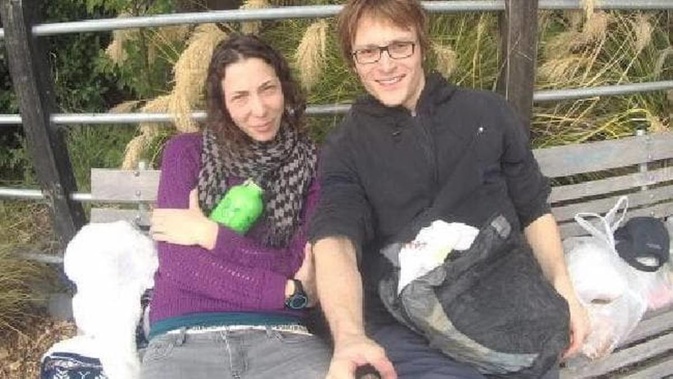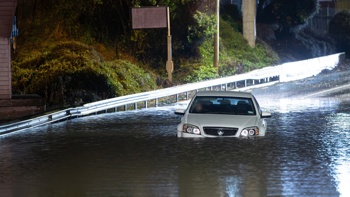
A Coroner's report released today has ruled Ondrej Petr's death was caused by "hypothermia in circumstances of alpine misadventure".
The 27-year-old died on the Routeburn Track on July 28, 2016, after a fall.
Stranded by gruelling weather conditions, his partner Pavlina Pizova was found and rescued about a month later.
It was a tragic, harrowing ordeal that captured the attention of the nation.
Pizova gave a detailed police interview on August 25 and her notes were provided to Coroner Anna Tutton for the inquiry into Petr's death.
Prior to embarking on the track the couple had been warned not to attempt it due to the tough winter conditions, but they decided to "give it a go" due to lack of recent snowfall, the Coroner's report reads.
They travelled lightly and did not notify anyone of their plans in a bid to avoid paying for huts.
Pizova would later remark this was "one of the big mistakes".
/arc-anglerfish-syd-prod-nzme.s3.amazonaws.com/public/TT6VTIRONFA7XHBZKNMP34ZM2A.jpg)
Source: Otago Daily Times
They had stayed overnight at Falls Hut before setting out for Routeburn Saddle or Harris Saddle in thick snow - trudging for five hours to complete a journey that usually would take one hour.
"The pair realised it was a difficult tramp, but thought it would be more dangerous to try to return than to carry on," the report read.
Dark had fallen by 5pm and the weather suddenly deteriorated, with fog and high winds setting in.
Helped by headlamps the pair could still not see more than a metre ahead.
They believed they could see lights coming from Gunns Camp in Hollyford Valley but coming across their own footprints made them realise they were lost and were "going in circles".
The couple decided to stay put overnight because there was no visibility.
They had no tent and instead secured a flap to a rock to make cover amid heavy snowfall.
Pizova was so worried they would be buried by snow by the morning she could not sleep.
/arc-anglerfish-syd-prod-nzme.s3.amazonaws.com/public/VDC5COO5KFFRZBNAIW63ANX2FA.jpg)
Pavlina Pizova was missing on the Routeburn Track for over a month before she was rescued. Photo / Facebook
By morning the pair were soaked and "completely blue".
The weather again deteriorated and they wanted to go back.
"We'll give it a go another time," Petr said.
They attempted to take a shortcut away from the track but became disorientated heading up the valley rather than down as intended.
In a bid to find the track again they climbed up above the bush line.
Both tired and hypothermic, they agreed Pizova would venture ahead.
She saw the top of the ridge and believed the pair could make it. But upon reaching the ridge she could not see lights or the lake.
Suddenly the snow gave way and the pair fell.
Petr fell further than Pizova, who was able to get to him, but could not free him from branches and rocks in which he was tangled.
She was exhausted.
As he moved, he fell "deeper and deeper" and was starting to suffocate.
Pizova could hear him gasping as he started to disappear.
After some time, she could no longer hear him breathing.
With the aid of a headlamp she checked for a pulse and realised he had died.
/arc-anglerfish-syd-prod-nzme.s3.amazonaws.com/public/PZ3ANRPBW5CG7BGKSNFFUNLUDM.jpg)
The recovery team at work off the Routeburn Track, trying to recover the body of Czech climber Ondrej Petr. Photo / Police
Pizova spent the night there before heading to the Lake Mackenzie warden's hut - which is self-contained with cooking and heating facilities.
She smashed her way inside the locked hut but was unable to work the radio.
For the next four weeks she existed on meagre supplies of food, firewood and gas left behind by DoC workers.
While confined to the hut area, Pizova saw aircraft flying overhead and would wave clothing to attract attention.
On one occasion, she arranged ashes from the fire outside in the shape of the "H" - a signal for help.
Grieving and pained by frostbite on her hands and feet, she found it difficult to sleep.
After noticing concerned Facebook posts from relatives, the Czech Republic Honorary Consul raised an alarm with DOC on August 24.
Petr and Pizova were reported missing to police that day and their vehicle, which contained clues to their disappearance, was found parked at Routeburn Track carpark.
As a rescue helicopter neared Lake McKenzie, its occupants could see a person was jumping up and down in front of a hut.
One of its occupants, Constable Andrew, immediately recognised Pizova as the woman they had been looking for.
He said she was overwhelmed.
/arc-anglerfish-syd-prod-nzme.s3.amazonaws.com/public/RQNZSAGYUVH7NJ2V3IMUKOT6WA.jpg)
The exterior of the warden's hut at Lake Mackenzie. Photo / Police
Pizova spoke to reporters after the ordeal, describing it as "harrowing" and her partner's fall and death as a "tragic accident".
The New Zealand Mountain Safety Council (MSC) provided a report on the incident for the Coroner, concluding that while the ultimate cause of Petr's death was hypothermia, there were many opportunities to make decisions that "almost certainly" would have led to a different outcome.
"The authors wrote that, although Ms Pizova was aware that Mr Petr was suffering
from hypothermia, it appears she took no action to treat or manage this," the Coroner's report said.
The authors believed several interventions could have been life-saving including: turning back to the Falls Hut early; staying overnight at the Harris Shelter before re-evaluating their plan; carrying a form of alpine-suitable shelter and treating Petr's hypothermia.
The MSC issued the following recommendations in the report:
- Before heading off on any adventure, discuss and identify decision-making points
where you'll stop and evaluate your progress, considering if any changes need to be
made to your plans. This includes always having alternative options available and
understanding your limits. - Go into any adventure with the mindset that you may have to change your plans along
the way and be prepared to accept that turning around is ok. - Check warnings and alerts and act on the advice given by authorities.
- Talk with others who have local knowledge about your adventure. Seriously consider
the advice you're given and don't dismiss it as not relevant to you without careful
consideration. - Check the most recent weather forecast, and re-check up to the point of leaving as this
can change. Make sure you understand what this will mean for you, if you don't know
then seek advice from others who do. - Take sufficient supplies, including waterproof clothing, at all times of the year. In
winter or when snow conditions may exist this should also extend to waterproof pants
and snow gaiters. - Be prepared for the fact you may not make your intended destination. Carry an
emergency shelter, spare warm clothing, emergency communication device and
appropriate food.
Take your Radio, Podcasts and Music with you









